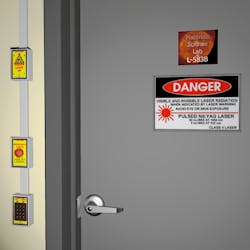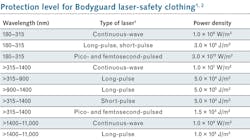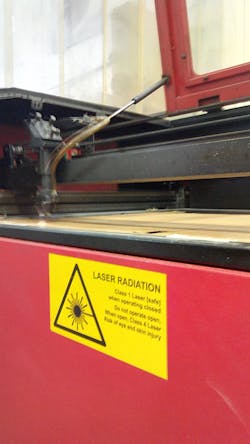Photonics Products: Laser Safety Equipment - Laser safety is an industry unto itself
The world of laser safety is a large one. While the first thing that many people buy as protection from hazardous laser light might be eyewear, laser safety encompasses many other types of equipment. This includes windows, barriers and curtains, enclosures, clothes, interlocks, shutters, signs, and other less tangible goods, such as hazard assessments, audits, laser-safety training, and information sources.
With this in mind, this short article will not attempt anything like a complete overview—instead, just a few examples of laser-safety equipment will be covered. For a true starting point, at the end of this article you will find a list of some laser-safety-related companies and the types of products they produce.
The all-important eyewear
Because the eye is far more sensitive to damage by light in or near the visible spectral region than is any other part of the human body, proper eyewear is of prime importance to laser safety (see Fig. 1). For many low-power laser applications, laser-safety eyewear is all that is needed.
As Tyler Parker, product manager at Newport (Irvine, CA) explains, "Laser-safety eyewear is important because without it users are more likely to physically damage their eyesight from direct or indirect laser light and incoherent light sources. Lasers come in all shapes and sizes with many different wavelengths, power levels, and pulse characteristics. It is impossible to create one single piece of eyewear to cover the entire spectrum of lasers, so we offer many different choices for users to select the proper protection they require for the laser system." He notes that the company's selection of eyewear is supplied by Honeywell Safety Products (Smithfield, RI) and Laservision (St. Paul, MN).
Many types of users rely on laser-safety eyewear, Parker says. "Most common is likely our research customers, who are working and aligning lasers that could potentially damage their eyesight," he adds. "The eyewear is very important, as the user is working very close to direct laser beam paths. Also, stray reflections are not always very obvious, especially with an infrared laser beam. Other applications include industrial processing, medical device manufacturing, medical applications, among many others."
Newport carries both polycarbonate and glass-type eyewear, Parker says. The polycarbonate is much lighter for users to wear, but sometimes cannot provide as much protection as glass. The glass type tends to be more robust for users and is more resistant to scratches, but also tends to come with a higher price tag. "We even have some eyewear that takes advantage of some multilayer filters for expanded protection for the user," he says.
Tom MacMullin, president of Kentek (Pittsfield, NH), a company that supplies a range of laser-safety equipment and services, describes the technical differences between the materials in his company's types of eyewear.
"Kentek laser eyewear combines or uses stand-alone several technologies," MacMullin says. "Polycarbonate eyewear from Kentek, all of which meet ANSI Z136 and ANSI Z87, use the latest in dye and pigment technologies to create safety lenses that absorb laser radiation and convert that energy into heat. Filter-glass eyewear also protects by absorption, but uses minerals diffused in the glass materials to achieve this. Coatings on glass or polymer substrates are used to affect laser protection through reflection; many coated laser-safety products have the appearance of a mirror. Finally, for complicated laser-safety situations, Kentek will combine these technologies in a single product."
Laser barriers and interlocks
Protecting humans and their possessions from the light of all but low-power and low-energy lasers is done using barriers of all sorts, along with interlocks (sensing systems that make sure that, if a laser's enclosure is opened or otherwise breached, the laser is switched off before damage is done) and good procedure, including the use of warning signs.
As described by MacMullin, laser barriers are used for safety of personnel in defined areas. "The materials we use include fabrics and metals; the products are designed to block stray laser radiation," he says. "Laser barriers take several forms: curtains, partitions, wall coverings, window shades, window blocks, and optical table surrounds."
For example, Kentek's Entry-Guard safety interlock system provides a fail-safe access control system, with the primary function of ensuring that unauthorized personnel are prohibited from areas where laser radiation may be present. "When the power to the controller is interrupted, critical outputs, such as door magnetic locks and laser interlocks, revert to a safe state: magnetic locks off, laser interlocks open," MacMullin says.
According to MacMullin, the company's Ever-Guard all-metal laser containment products have a damage threshold that is well above the stated rating of 1200 W/cm2, per the ANSI Z136 standard. The barriers are cleanroom-compatible and work with most interlocks. In curtain-style configurations, knuckle-style joints in the patented configuration ensure complete light blocking for curtain heights up to 10 ft. tall.
In one example, the Ever-Guard laser barrier curtains were chosen by Trumpf (Farmington, CT) to create a safety-zone walkway through a laser production and testing facility (see Fig. 2). Several testing bays were segregated by Ever-Guard laser curtains, while custom Ever-Guard laser barrier panels created separation in the interior of the bays. Kentek's product was chosen because of the power rating and cleanroom requirements.
John Hansknecht, vice president of Laser Safety Systems (Williamsburg, VA), says that his company saw a need for a staged approach to interlock systems that would let users install a simple minimal system at a low cost, but still have the ability to expand as their needs and budget would allow. The result was a modular system in which each module mounts inside a normal single-gang or dual-gang electrical outlet box just like a switch plate on a wall, making it convenient for electricians to prepare a room in preconstruction and to allow the use of surface-track and surface-mount boxes in existing rooms (see Fig. 3).For example, a laser application might just require a simple warning module interlocked to the laser and installed outside the front door of the hazard area, or it may require defeatable or non-defeatable access control modules that can monitor a door or laser curtain. Each module has a specific single function and is added to a main control cable to perform that function.
An example is the LSS-2384 module, which is the final interlock module that attaches to a laser or shutter. The module connects to the main interlock cable, where it receives control power and indication of the interlock state. It displays the status of the room-interlock armed state and the status of its own local contacts. If the overall room interlock is not armed, this module cannot arm. Once the room is armed, this module may be locally armed.
"If a client has a simple configuration with only one laser in a room, this module can be configured to arm automatically whenever the room is armed," Hansknecht says. "In situations where a room contains many lasers or laser systems, the ability to locally control each independent interlock becomes a useful option."
Some of Laser Safety Systems' clients are major manufacturers with a large room full of curtained-off cubicles for life testing of their laser product, Hansknecht explains. The modular approach has been beneficial to the users' engineered safety plan because they can arm an overall room interlock and then individually arm each cubicle, he says. In fact, users have been able to interlock their lasers and activate a local warning lamp above each cubicle to show the working status of each area.
Laser-blocking blinds from RT Technologies (Dunwoody, GA), which protect employees and third parties from stray laser radiation, can be fitted to cover windows and doors with windows built in, says Melody Castleberry of RT Technologies. The blinds, which are supplied by Lasermet (Bournemouth, England), can be operated manually by chain or crank. Alternatively, the motorized version can be operated by remote control—either wireless or hard-wired. The blinds are designed as a passive guarding system to block laser light from escaping the operating room, laboratory, or laser facility where Class 3B or Class 4 lasers are in use.
"We recently installed laser-blocking blinds at a hospital in Illinois," Castleberry says. "The blinds are being used in their operating rooms to protect the doctors and patients from stray laser beams. Our blinds are easy to clean and help to promote a clean environment."Out of the multitude of laser-safety product types, two more will be briefly mentioned. Protect-Laserschutz (Nürnberg, Germany) is another company with a multiplicity of laser-safety products, but of particular note here is its Bodyguard line of laser-safety clothing. Made of a "eudermic" (comfortable to the skin) laser-safety material, the clothing, in the form of a coat or of pants and a jacket, along with gloves, resists high powers and energies from a range of laser types (see table). The clothing can be laundered in a conventional washing machine.
Laser-safety signs and labels are an essential part of any laser setup that may present hazards. Such signs, which are part of the product lines of many laser-safety companies, range from general, easily-seen warnings to more-specific descriptions of wavelengths, powers, or laser classes (see Fig. 4).
Many of the companies in the list provided at the end of this article are members of the Laser Institute of America (LIA; Orlando, FL), a professional society that itself has extensive information on laser safety. For more information, see www.lia.org.
REFERENCES
1. See http://bit.ly/2hoKpqA.
2. See http://bit.ly/2ielTu7.
For More Information
Some laser-safety companies and their product types include:
Beamstopr
stock and custom curtains, screens, tents, enclosures, rooms, window coverings
Lyndhurst, OH
www.beamstopr.com
Brandstrom Instruments
shutters
Ridgefield, CT
www.brandstrominstruments.com
Brinell Vision
eyewear, filters
Dundee, Scotland
www.brinellvision.com
Cal-Av Labs
signs
Tucson, AZ
www.cal-av.com
Edmund Optics
eyewear, barriers, windows, window films, filters, shutters, signs
Barrington, NJ
www.edmundoptics.com
Honeywell Safety Products
eyewear, barriers, windows, training
Smithfield, RI
www.honeywellsafety.com
Kentek
stock and custom rooms, barriers, curtains, interlock systems, windows, removable films, signs and labels, beam dumps and traps, infrared viewers and beam-finding detectors, training and audits, laser-safety glasses for pilots
Pittsfield, NH
www.kenteklaserstore.com
Lasermet
eyewear, curtains, screens, blinds, windows, enclosures, rooms, interlock systems, signs and labels, shutters, beam dumps, software, audio alerts
Bournemouth, England
www.lasermet.com
Laservision
eyewear, barriers, filters, windows and domes, signs and labels, goggles for pets, audits and training
St. Paul, MN
www.lasersafety.com
Laser Safety Industries
eyewear and face shields, windows, barriers, signs, labels, training, books and videos, standards
Minneapolis, MN
www.lasersafetyindustries.com
Laser Safety Systems
interlock modules, systems, and supplies
Williamsburg, VA
www.lasersafetysystems.com
LVR Optical
radiation assessment, training, software, and products for the laser entertainment industry, including a professional audience-scanning system to determine laser exposure levels
Meathop, Cumbria, England
www.lvroptical.com
Melles Griot
shutters
Rochester, NY
http://mellesgriot.com
Newport
eyewear, curtains, windows, shutters
Irvine, CA
www.newport.com
NmLaser
shutters
San Jose, CA
http://nmlaser.com
NoIR LaserShields
polymer, glass, and thin-film shields; eyewear; windows
South Lyon, MI
www.lasershields.com
OptoSigma
eyewear, face shields, windows, films, curtains, panels
Santa Ana, CA
www.global-optosigma.com
Plixo
signs and labels
Singapore
www.plixo.com.sg
Protect-Laserschutz
eyewear, windows, curtains, panels, rooms, clothing, infrared viewers
Nürnberg, Germany
http://protect-laserschutz.de
Rockwell Laser Industries
eyewear, face shields, barriers, signs and labels, entryway control systems, hazard analysis software, training, standards
Cincinnati, OH
www.rli.com
RT Technologies
eyewear, blinds, curtains, and screens, filter windows, enclosures, interlock systems, shutters, signs and labels, product certification
Dunwoody, GA
www.rtlasersafety.com
Thorlabs
eyewear, curtains, barriers, screens, beam blocks and traps, shutters, blackout materials, signs
Newton, NJ
www.thorlabs.com
Vincent Associates
shutters
Rochester, NY
www.uniblitz.com
For a complete listing of companies making laser safety equipment, visit the Laser Focus World Buyers Guide (http://buyersguide.laserfocusworld.com/index.html).
DISCLAIMER: While we try to include information from the broadest possible number of companies that manufacture the products featured in our Photonics Products series, because of limited word count as well as deadlines that cannot always be met by requested contributors, we cannot possibly include all companies and regret if your company is not included in our series.
About the Author
John Wallace
Senior Technical Editor (1998-2022)
John Wallace was with Laser Focus World for nearly 25 years, retiring in late June 2022. He obtained a bachelor's degree in mechanical engineering and physics at Rutgers University and a master's in optical engineering at the University of Rochester. Before becoming an editor, John worked as an engineer at RCA, Exxon, Eastman Kodak, and GCA Corporation.





